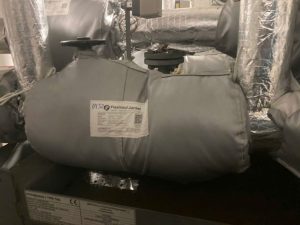Choosing between removable insulation jackets and fixed insulation is a critical decision that directly impacts energy efficiency, operating costs, and workplace safety in a facility. Each solution has its own pros and cons, suiting different needs and installation locations.
This article will provide an in-depth comparison of the two methods, offering clear criteria to help businesses make the smartest and most effective choice.
Understanding Two Common Industrial Insulation Solutions
In an industrial environment, controlling heat loss is vital for optimizing processes and costs. The two leading insulation solutions today are traditional fixed insulation and flexible removable insulation jackets.
What is Fixed Insulation?
This is the traditional method, using materials like mineral wool, fiberglass, or foam wrapped around equipment and secured firmly with a metal cladding (aluminum, stainless steel, galvanized steel). This system is very durable, but once installed, it is nearly impossible to remove for reuse.
What are Removable Insulation Jackets (Insulation Blankets)?
An insulation jacket is a new-generation insulation product, custom-designed and fabricated to the 3D shape of each piece of equipment (valves, flanges, expansion joints, machine bodies). They consist of multiple layers of heat-resistant, waterproof materials, secured with straps and hook-and-loop fasteners (Velcro), allowing for extremely quick and easy removal and reinstallation.
Detailed Comparison: Removable Insulation Jackets vs. Fixed Insulation
For a comprehensive view, let’s compare the two solutions based on key criteria.
1. Flexibility and Reusability
- Removable Jackets: Far superior. They can be removed and installed in minutes without special tools, ideal for equipment inspection and maintenance. The product can be reused countless times throughout its lifespan.
- Fixed Insulation: Virtually zero. When maintenance is required, the cladding and insulation material must be destroyed, leading to costly material and labor expenses to reinstall from scratch.
2. Investment Cost and Life Cycle Cost (LCC)
- Initial Cost: Fixed insulation often has a slightly lower initial material and installation cost for simple, straight pipelines. However, for complex-shaped equipment (valves, flanges), the installation cost for fixed insulation can be higher.
- Life Cycle Cost: Removable jackets offer superior long-term economic benefits. By eliminating the costs of removal and reinstallation for each maintenance cycle, the total cost of ownership for jackets is significantly lower, leading to a rapid return on investment.
3. Insulation Efficiency and Worker Safety
- Efficiency: Both solutions achieve high insulation efficiency if designed and installed correctly. Removable jackets are precisely tailored to fit equipment snugly, minimizing thermal bridging and energy loss.
- Safety: Removable jackets reduce equipment surface temperatures to a safe level, preventing burn injuries to workers. The gentle removal and installation process also minimizes accident risks compared to cutting and removing the sharp metal cladding of a fixed system.
4. Installation and Maintenance Time
- Installation: Installing removable jackets is much faster and simpler, requiring no specialized skills and causing minimal production disruption.
- Maintenance: This is the biggest advantage of removable jackets. Accessing equipment for maintenance takes only a few minutes, compared to hours or even a full day to dismantle fixed insulation.
Comparison Summary
About Removable Insulation Jackets: They excel in flexibility, reusability, quick maintenance, and low life cycle costs. This makes them the optimal choice for components requiring regular maintenance, such as valves, flanges, and joints.
About Fixed Insulation: It typically has a lower initial cost for straight pipelines but lacks flexibility, is not reusable, and has a high life cycle cost due to the need for destruction and reinstallation during maintenance.
When to Choose Which Solution?
The choice depends on the installation location and the company’s priorities.
When to Choose Removable Insulation Jackets:
- For components requiring frequent maintenance: Valves, flanges, expansion joints, filters, pumps, turbines, machine casings, etc.
- When prioritizing long-term costs: To save on operational and maintenance expenses over the product’s life cycle.
- When downtime reduction is critical: Needing quick access to equipment to minimize machine downtime.
- In confined spaces: Where the installation area is tight and difficult for fixed insulation work.
When to Choose Fixed Insulation:
- For low-maintenance areas: Long, straight pipeline systems with few inspection points.
- With a limited initial budget: When the upfront investment cost is the most critical factor.
- In harsh environments: Requiring sturdy metal cladding to withstand strong mechanical impacts.
The Hybrid Solution: Comprehensive Optimization
In many facilities, the most optimal solution is a combination of both:
- Use fixed insulation for long, straight sections of pipe.
- Use removable insulation jackets for all valves, flanges, joints, and other components on that pipeline.
This approach helps save on initial investment costs while ensuring flexibility for maintenance, delivering the highest overall economic efficiency.
Request consultation and quotation now!Frequently Asked Questions
Are removable insulation jackets durable?
Yes. Removable insulation jackets are made from specialized industrial materials with high durability, heat resistance, and water/UV resistance, ensuring a long service life in a factory environment.
Why should I use insulation jackets for valves and flanges?
Because valves and flanges are components that require regular inspection and maintenance. Insulation jackets allow for quick removal and reinstallation, saving labor costs and machine downtime compared to destroying and rebuilding fixed insulation.
How does the life cycle cost of removable jackets compare to fixed insulation?
The life cycle cost of removable jackets is significantly lower. Although the initial cost might be comparable or slightly higher, the ability to reuse them countless times for maintenance saves on removal and reinstallation costs, providing long-term economic benefits.










